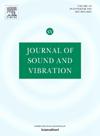Application of the harmonic balance method for ship-cargo interaction with intermittent contact nonlinearities
IF 4.3
2区 工程技术
Q1 ACOUSTICS
引用次数: 0
Abstract
An important trend exhibited by the offshore wind market is the increasing size of wind turbines, leading to longer and stiffer monopiles with larger diameter-to-thickness ratios. Current transport analysis is focused on loads resulting from hydrodynamic accelerations, without taking into account the loads resulting from differences in bending deflection between the vessel and cargo. This investigation examines the structural response of a monopile and sea-fastening system subjected to displacement-based loads. The load case follows from a vessel excited using a regular wave leading to bending deflections and rigid body accelerations. The intermittent contact between the saddles and monopile is modeled by representing the saddle with a unilateral spring. This requires the use of a nonlinear solution method to obtain structural responses. The harmonic nature of hydrodynamic-based loads led to the selection of the harmonic balance method (HBM) to model the cargo-sea-fastening system. A novel understanding is gained of how cargo properties, sea-fastening properties, and sea-fastening arrangements influence the structural response of the coupled cargo-sea-fastening system. Various parametric studies are performed to identify behaviors related to the total structural response. Based on this study, the conclusion can be drawn that a large number of saddles in combination with a low stiffness is desired to minimize the structural response of the cargo and sea-fastening system. Furthermore, the influence of lashing stiffness and pretension is limited with respect to the total response. Both these conclusions also hold for an increase in cargo length and diameter.
求助全文
约1分钟内获得全文
求助全文
来源期刊

Journal of Sound and Vibration
工程技术-工程:机械
CiteScore
9.10
自引率
10.60%
发文量
551
审稿时长
69 days
期刊介绍:
The Journal of Sound and Vibration (JSV) is an independent journal devoted to the prompt publication of original papers, both theoretical and experimental, that provide new information on any aspect of sound or vibration. There is an emphasis on fundamental work that has potential for practical application.
JSV was founded and operates on the premise that the subject of sound and vibration requires a journal that publishes papers of a high technical standard across the various subdisciplines, thus facilitating awareness of techniques and discoveries in one area that may be applicable in others.
 求助内容:
求助内容: 应助结果提醒方式:
应助结果提醒方式:


